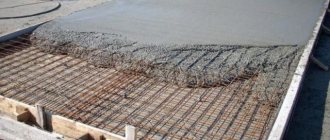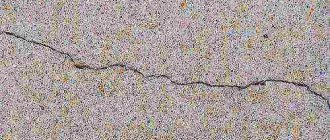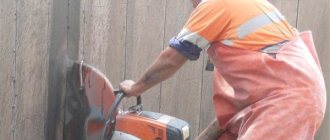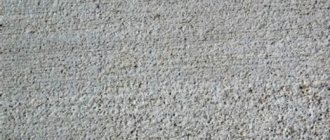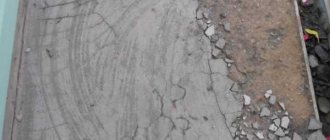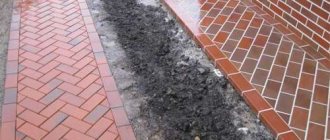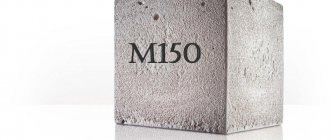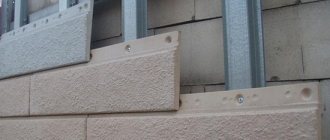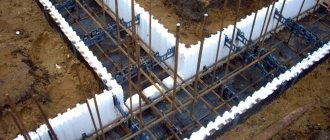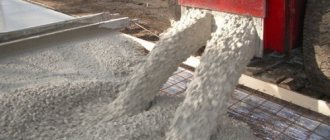Is it possible to pour concrete into water?
Hello! We recently drilled holes for a foundation 1.5 m deep, for a 6x6 log house; the next day water appeared there (loam). We are going to cover the hole with roofing felt and fill it with concrete. Do we need to pump out this water? Can someone tell me how to make an expansion at the bottom without a TISE drill and is M150 concrete suitable?
Thanks in advance everyone. I'm really looking forward to your answer, we plan to do the foundation on May 9th.
Concrete M150, if so, will do. Bayoneting, or better yet a vibrator, is a must. Concrete is better on granite crushed stone, but you can’t always guess it. The water needs to be pumped out. Ruberoid on the bottom is not necessary at all, it won’t help anything.
The expansion at the bottom can be done with a narrow spatula with a long handle. They already wrote about this somewhere.
Dear comrades, in my opinion you are muddying the waters.
1. About the fittings. After the foundation is loaded, it is switched off. Those. practically not needed.
2. Regarding the brand of concrete. She was not seriously injured because... the water was pushed out of the well by concrete. Those who wish can conduct an experiment: take a tin can, fill it with water, and pour concrete into it. You will see everything for yourself. In general, for a TISE pile, the most important thing is not the grade of concrete (M50 is enough for loads), but frost resistance. Even if some of the water is mixed with concrete at the very bottom, it will not have much effect
3. How is the grillage connected to the pile? It is enough that when pouring the pile will “sink” into the grillage by 1-2 cm. If the house is not on a slope, then no horizontal forces are applied to the grillage. After all, you don’t tie the bricks with vertical reinforcement when you lay a wall?
The lack of a shirt is a big omission here, I completely agree.
For a columnar foundation, reinforcement is required! I know two examples of pillars breaking in the ground. Plus, the freezing of the ground does not necessarily occur evenly, which means there will be lateral loads.
Moreover, their size can be even higher than the longitudinal one and 1-2 cm will not hold the connection between the grillage and the pile. If there really are no outlets, then you need to drill into the piles. I don’t know the exact depth, but it depends on the thickness of the reinforcement.
With a reinforcement diameter of 16 mm, my depth was 160 mm.
Please tell us more about the breaking of the pillars. Why did this happen and what were the consequences?
About horizontal forces. Even if the ground passes through unevenly, let’s not forget that the pillar is covered on all sides by earth, which resists compression. In addition, there are a lot of photographs on the Internet of poles without releases and it seems like nothing happened.
At the expense of horizontal forces. I haven’t looked into what’s going on there, maybe it really doesn’t freeze evenly, but I’ve seen more than once how piles stand like a fan (for example, a heating main in a lowland). Maybe the pillar is trying to bulge, it is loaded from above, so it is looking for a weak point, if the weak point is the side, then it will go there.
At the expense of horizontal forces. I haven’t looked into what’s going on there, maybe it really doesn’t freeze evenly, but I’ve seen more than once how piles stand like a fan (for example, a heating main in a lowland). Maybe the pillar is trying to bulge, it is loaded from above, so it is looking for a weak point, if the weak point is the side, then it will go there.
Another possible reason is the unevenness of the soil around the pillar - stones, sand, water. Void spaces that are not filled with soil after digging holes may have an effect. Where the soil is less dense, the slope of the stack will go there.
The most obvious example of broken pillars was in a neighbor's house. The construction is 15 years old. Every year, the roof and floor of its terrace, standing on separate pillars, rose by 10-15 cm by the end of winter, and unevenly. “The autopsy showed” that at a depth of 30-40 cm from the surface, both pillars had cracks. I don’t deny that the concrete was of poor quality, but it’s just a fact. After casting the new “correct”
Source: https://1pofundamentu.ru/mozhno-li-zalivat-beton-v-vodu.html
Technology of pouring concrete into water step by step
Pouring concrete into water is one of the methods used during construction on soil with high groundwater levels. The hole dug under the foundation often fills with water.
Of course, there are no ideal territories. Basically, soils contain clay and sand, which by their structure retain water. In winter, it freezes, which leads to heaving of the soil. The manifestation of this phenomenon is influenced by the composition and porosity, as well as the groundwater level.
The influence of underground and groundwater on the foundation
All water that is below the ground is underground. All of them negatively affect the main characteristic of the soil, which is determined by the degree of compaction and the ability to saturate with moisture. Therefore, the planning and construction of the foundation takes into account any changes in the soil, both during construction and over time of operation.
Based on seasonal fluctuations in groundwater levels and soil aggressiveness, foundation construction methods are selected.
Using the pump
The liquid below the surface is bound in the form of vapor and ice. It can be hygroscopic and film-like.
The forces of attraction of water molecules to soil particles depend on the distance from the molecule to the soil particles and decrease, and at 0.6 microns they no longer interact.
The first layers are firmly held due to the force of attraction of water to the ground and form hygroscopic moisture. The increase in water creates film water and free water is formed.
Groundwater is associated with gravitational forces, and its movement depends on the influence of gravity. There are capillaries in the soil, and the water through them begins to rise higher than the level of gravitational water. Tensile forces hold it in place. The lifting height depends on the diameter and can reach several meters. The less, the higher the water rises.
Choosing a foundation depending on the soil
The soil and foundation are interconnected. Liquids below the surface can dissolve salts and gases, causing them to become corrosive and can destroy the concrete foundation of the house. The rate of destruction depends on the speed of water movement. Therefore, special cement is used.
How to change humidity?
By investing additional money in materials, you can speed up the repair process. Almost all acceleration methods lead to certain coating defects, so they must be used strictly in accordance with the manufacturer’s instructions.
To change the parameters of the initial composition use:
- Expanded clay, basalt fibers - affect the modification. The amount of wateriness is reduced by 41%. You can lay tiles on the fifth day of downtime, and lay laminate after 22 days;
- Thinner - slows down setting, increases the fluidity of the solution, water leaves the lower level;
- Pore formers – accelerate fluid loss and reduce strength. To compensate, special resins are added. Porous sand concrete mixture conducts cold and heat worse;
- Sound insulators - act as interfloor insulation.
How to pour concrete into water the right way
This type of concreting is used in hydraulic structures and in places where groundwater lies close to the surface. High levels are a common problem in construction. Some areas are constantly in water.
Land for construction is often sold for the price of a non-flooded area, and the groundwater level, as promised, should never be disturbed.
All shortcomings will be discovered during the work process. There are many ways to divert water away from the site and pour concrete directly into the water. How to fill, and is such an activity dangerous for the foundation in the future?
Is it possible to do this
Concrete can be poured into water, but this type of pouring has its own characteristics. Concrete work is a critical stage in construction. Work begins with the construction of the foundation. Failure to follow the simplest rules for laying concrete results in the formation of cracks. Weak load-bearing capacity leads to a short lifespan of the structure.
Underwater concreting is one of the methods of industrial and civil construction. Private owners in rare cases practice pouring mortar into formwork when there is water in the pit. You have to adjust the outflow from your site in the direction of the slope and fight to drain the site.
With the help of modern materials for insulation and repair, it is easy to obtain a concrete mixture for waterproof concrete in field conditions. The solution can even be supplied under water using standard underwater concreting methods. The result is reliable waterproof concrete.
The effect of water on the foundation
Water has a negative effect on the foundation. According to its physical properties, when it freezes, water becomes larger in volume. When air temperatures drop below freezing, cracks and holes where water has entered expand and become larger. Over time, the foundation weakens and collapses.
Groundwater in the upper layers causes a lot of concern, including precipitation from rain and sleet. Impurities in water have chemical compounds with aggressive technical emissions into the atmosphere. Waste oil and car exhaust gases settle on the surface of concrete. Erosion occurs under the influence of harmful substances. The structure loses strength, begins to crumble, peel and crumble.
Water has the ability to wash away everything that comes in its way. Even under the influence of clean water, without impurities, the water constantly and gradually washes away foundation particles, pores, caverns, and other defects appear.
What influences the gain of maximum strength?
The vast majority of concrete work is carried out outdoors.
Weather conditions and temperature schedule are the key parameters that determine how long the solution hardens.
During the warm season, the mixture matures and gradually hardens naturally. The process depends on the physical and chemical properties of the composition and has slight differences associated with the brand of concrete.
In the autumn-winter period, strength gain is provided in two ways:
- Antifreeze additives.
Used to preserve the properties of the prepared solution. Special substances prevent water from freezing and loss of quality, making it easier to fill the structure and level the surface; - Electric heating
It is carried out by several methods with a common essence - ensuring uniform heating of the concrete thickness during the period necessary to gain strength.
At low temperatures, PNSV wires are used or electrodes are “implanted” into the material, after which the voltage is connected. Less commonly, the formwork itself is used as a heating element; the surface is covered with special mats.
The work requires compliance with electrical safety rules and is carried out in accordance with SNiP 3.03.01-87. If the minimum temperature reaches 0°C and the daily average does not exceed 5°C, concreting is initially planned with heating of the poured structure. If necessary, PMD is included in the solution.
How to pour concrete in water?
It is difficult to imagine modern construction without the construction of elements of a building structure under water. Often such work is carried out during the construction of a dam, bridge, well, and other underwater structures penetrating to a depth of up to fifty meters.
Is concreting possible in water?
When building an ordinary house, a prerequisite will be the absence of water at the bottom of the foundation pit. The groundwater level plays an important role during concreting. Industrial construction of structures under water is possible. This operation is performed during the construction of breakwaters, piers, and other structures of hydraulic engineering importance.
Types of technologies and their description
There are two ways to pour concrete mixture in water. At shallow depths and low water fluctuations, with the help of jumpers - piles, a fence is created, which is filled with concrete mixture. You can also pour the solution directly into the water in a calm, shallow place.
In a deep-sea location, construction is carried out using an air chamber that ensures watertightness - a caisson. The chamber is filled with solution using a special pipe.
Using piles
Sheet piles can be used to construct a concrete structure in water. Piles are the building elements of a sheet pile row - an empty pipe or a pile that has a locking connection system: tongue and groove. This method allows you to build a durable structure with a maximum depth of fifty meters.
Before work you need to prepare:
- solution;
- installed row of piles;
- lifting rope;
- pipe;
- funnel for loading solution;
- lift.
Initially, you need to prepare the construction site above the construction site. A lift is installed on it, to which a pipe with a cross-section of over twenty centimeters is hung. For uniform and correct pouring of the mixture, the lifting cable with workers must quickly rise and fall. The accuracy should be less than three centimeters.
The pipe is filled with a bag that does not allow water to penetrate and wash out the solution. The mixture is fed into the bag through a funnel - as the base of the pipe becomes heavier, it lowers, squeezing out the water. The pipe is filled tightly and completely.
The technology is characterized by multi-level pouring of concrete. Each level has a fragile top layer where water can get in, so the top layer is removed before the next level is built.
A larger gap is filled with concrete using several pipes with a large cross-section.
The solution should lie down to dry a little. By pouring such concrete, it is possible to ensure a small loss of the mixture being washed out by water. While the solution is drying, it should be covered with a tarpaulin from the sun or rain.
If the weather permits, you don't have to cover it. The technique that used piles was first used by the British engineer Kinipple. The solution is used in different densities.
Is it possible to pour concrete into water and what methods exist?
Concreting in water is used both in the construction of hydraulic structures (breakwaters, bridge supports, piers, berths, etc.) and in private low-rise construction in conditions of high groundwater.
Is it possible to pour concrete mortar into water?
The answer is positive: “Yes! Not only is it possible and necessary!” At this point in time, there are four technologies for pouring concrete into water:
- "Rising pipe" technology;
- Caisson method;
- Concreting using bags filled with mortar;
The first two options are used in industrial construction. The latter method is usually used in private low-rise construction.
Up-pipe technology
In general, the following equipment and materials will be required:
- Concrete mixture (two types);
- Pile platform (flooring above the platform);
- Lifting device: floating crane, hoist or winch;
- Pipes;
- Traverse;
- Formwork for fencing off the enclosed space of a concreting object from the water of a reservoir;
- Hopper.
The “rising pipe” method (pile method) allows the construction of durable concrete structures in water at shallow depths. A work platform is erected on the surface of the reservoir directly above the structure under construction, on piles driven into the bottom.
A traverse is installed on the platform, from which a supply pipe with a diameter of at least 200 millimeters is suspended. In this case, the pipes are lowered and raised using a hoist or winch.
The ideal option is to lift and lower using a floating crane, and supply concrete using a concrete pump. Depending on the dimensions of the structure being built, there may be several loading pipes.
Is it possible to pour concrete into water without preparatory work? In no case. Before pouring begins, the bottom of the proposed structure is covered with thick fabric (canvas or tarpaulin) overlapping the formwork and leveled with stone and crushed stone filling. This is done to avoid concrete leakage through changes in the topography of the bottom of the reservoir.
Two types of concrete are used for pouring: “saturated” and “unsaturated”. The first is laid around the perimeter of the formwork, and the second is poured into the core of the structure. Moreover, before pouring, both types of concrete must be kept in the air, in the shade for 5 and 3 hours, respectively.
The actual filling process is as follows. The pipe sinks to the bottom of the reservoir. Concrete is fed into the pipe until the entire pipe space is filled. Next, using a lifting device, they begin to lift the pipe - the concrete is unloaded to the bottom of the reservoir. The layer-by-layer pouring process is repeated until the entire structure is filled.
Important! Care should be taken that each lower layer of concrete does not turn into stone and is in a semi-liquid state. In addition, this method of underwater concreting is possible in reservoirs where there are no strong currents or significant waves.
Underwater concreting with cement bags
Bags filled with concrete mortar are used, similar to the type of base construction for caisson concreting. A saturated concrete solution is mixed and filled into pre-prepared bags. Next, a trench or pit is filled with bags of liquid solution (above the level of nearby groundwater).
The structure is maintained for at least 30 days, after which formwork is erected around the object and pouring (of the foundation or walls) is carried out using classical technology.
Source: https://salecement.ru/mozhno-li-zalivat-beton-v-vodu/
Controlling the consistency of the concrete mixture
Control is important. It determines how well the solution was made, what materials were used, in what quantities, how much water was used so that there is no delamination in the future. There is a fairly familiar situation in construction when the first mixtures turn out to be either too rigid or mobile. Based on the sediment of the cone, they determine how well the consistency is made and what percentage of moisture is present. This method helps to understand whether there were errors in the dosage of materials.
Concrete delamination is a phenomenon that occurs quite often in the repair and construction industry due to uneven loads. It can be determined both by external defects and by hearing. But the second method is good for small areas.
To do this, use a hammer to gently tap the poured surface. When a dull sound is heard, this indicates that peeling has occurred. If you notice that during the inspection the peeled area occupies more than a third of the filled area, you should dismantle it and refill it.
On larger areas, delamination can already be noticed by errors in the manufacture and installation of the mortar. When the concrete mixture delaminates, it is necessary to correct the situation immediately in order to save money and avoid rework later.
